Analysis of Badminton Tactical Strategy for Enhanced Performance
VerifiedAdded on 2022/08/13
|9
|2247
|13
Project
AI Summary
This project analyzes a badminton tactical strategy, focusing on doubles play. The student explores the concept of non-linear learning, tactical awareness, and the importance of good footwork. The paper details the student's chosen tactical strategy, the principle of attack, and the double position strategy, explaining how they are applied in the game. The student gathered information from rule books, watched other players play, and used video footage to analyze their performance. The project also examines the constraints affecting performance, including learner, task, and environmental constraints. The evaluation section assesses the effectiveness of the chosen strategies in enhancing performance and movement during both attacking and defensive plays, considering limitations and implications.
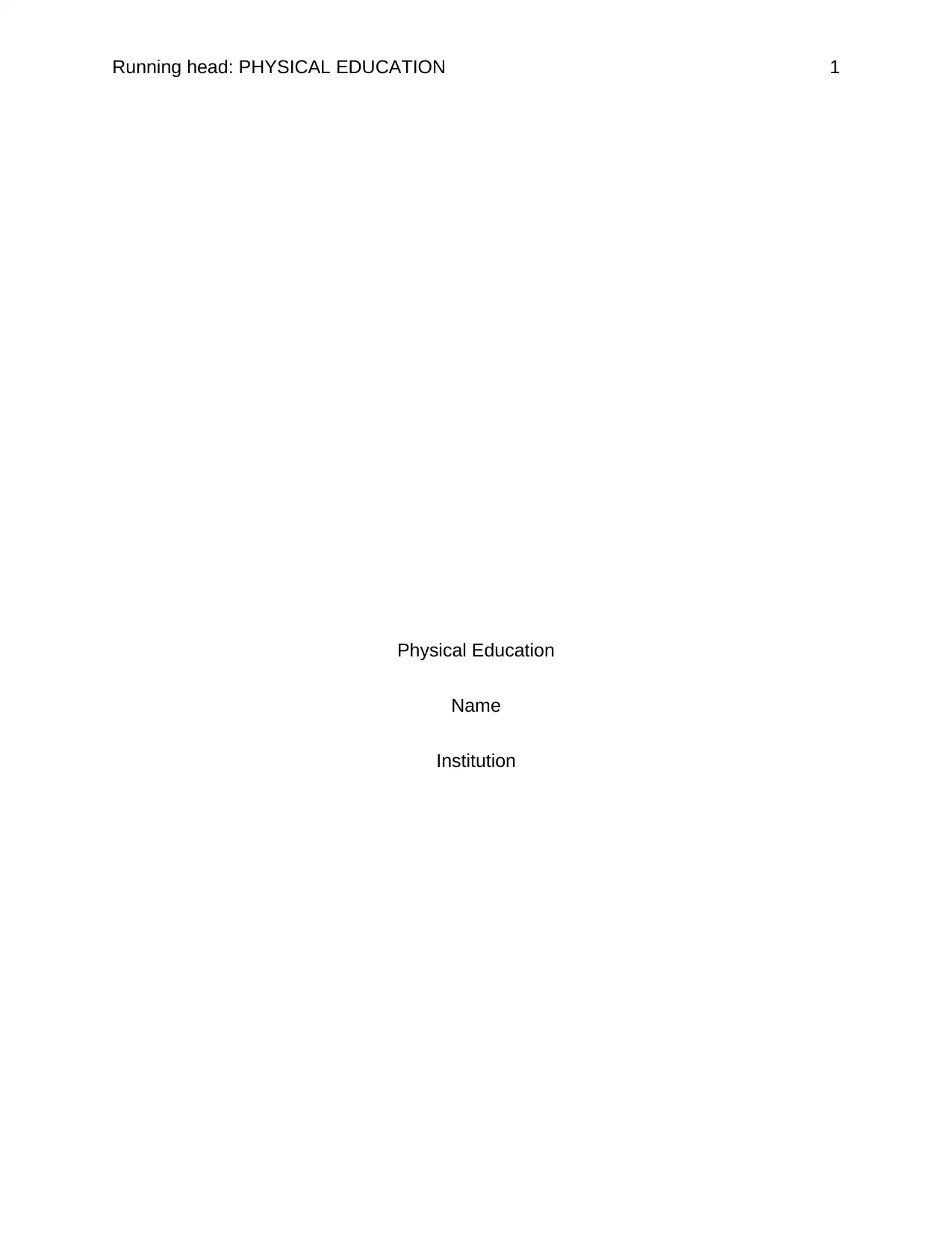
Running head: PHYSICAL EDUCATION 1
Physical Education
Name
Institution
Physical Education
Name
Institution
Paraphrase This Document
Need a fresh take? Get an instant paraphrase of this document with our AI Paraphraser
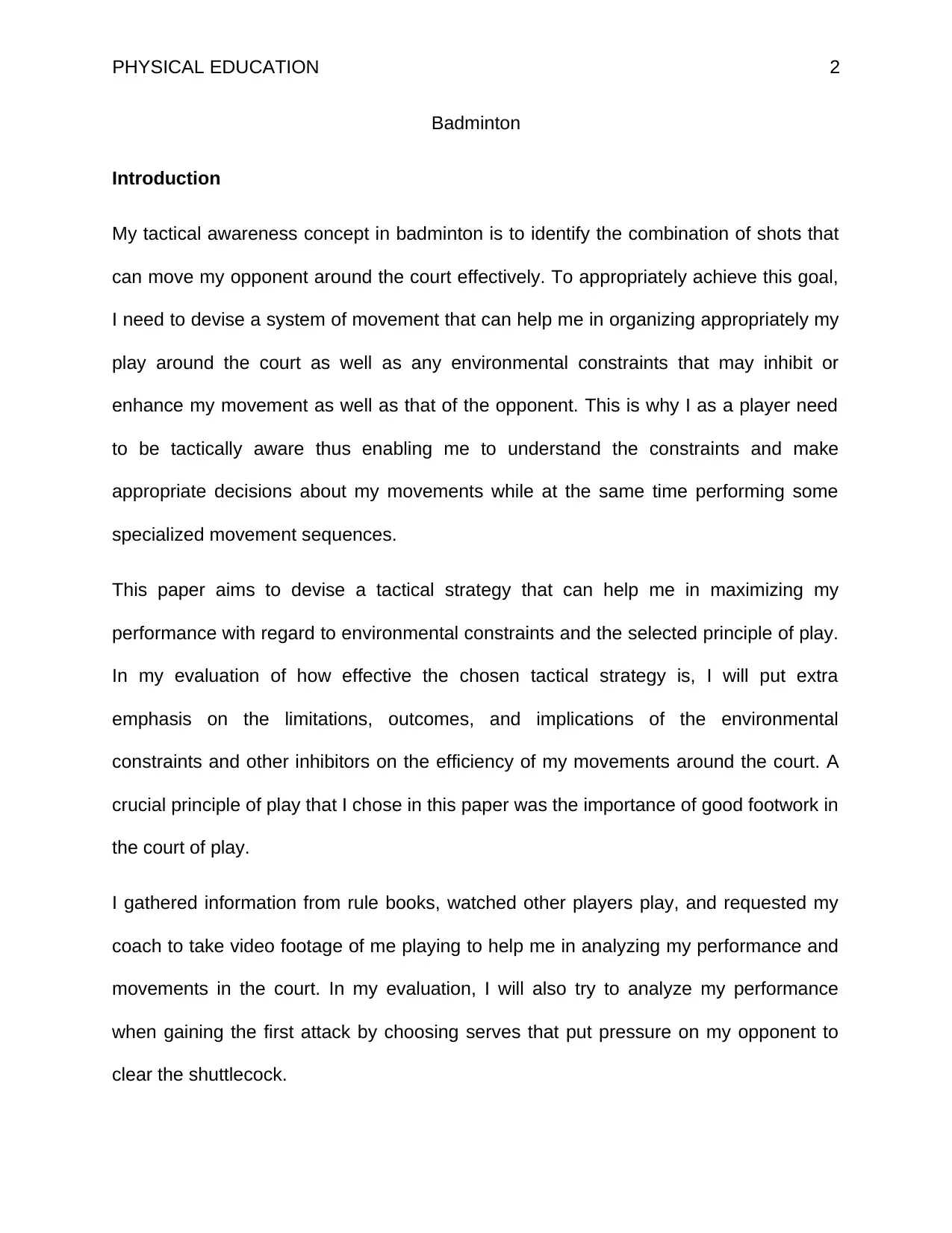
PHYSICAL EDUCATION 2
Badminton
Introduction
My tactical awareness concept in badminton is to identify the combination of shots that
can move my opponent around the court effectively. To appropriately achieve this goal,
I need to devise a system of movement that can help me in organizing appropriately my
play around the court as well as any environmental constraints that may inhibit or
enhance my movement as well as that of the opponent. This is why I as a player need
to be tactically aware thus enabling me to understand the constraints and make
appropriate decisions about my movements while at the same time performing some
specialized movement sequences.
This paper aims to devise a tactical strategy that can help me in maximizing my
performance with regard to environmental constraints and the selected principle of play.
In my evaluation of how effective the chosen tactical strategy is, I will put extra
emphasis on the limitations, outcomes, and implications of the environmental
constraints and other inhibitors on the efficiency of my movements around the court. A
crucial principle of play that I chose in this paper was the importance of good footwork in
the court of play.
I gathered information from rule books, watched other players play, and requested my
coach to take video footage of me playing to help me in analyzing my performance and
movements in the court. In my evaluation, I will also try to analyze my performance
when gaining the first attack by choosing serves that put pressure on my opponent to
clear the shuttlecock.
Badminton
Introduction
My tactical awareness concept in badminton is to identify the combination of shots that
can move my opponent around the court effectively. To appropriately achieve this goal,
I need to devise a system of movement that can help me in organizing appropriately my
play around the court as well as any environmental constraints that may inhibit or
enhance my movement as well as that of the opponent. This is why I as a player need
to be tactically aware thus enabling me to understand the constraints and make
appropriate decisions about my movements while at the same time performing some
specialized movement sequences.
This paper aims to devise a tactical strategy that can help me in maximizing my
performance with regard to environmental constraints and the selected principle of play.
In my evaluation of how effective the chosen tactical strategy is, I will put extra
emphasis on the limitations, outcomes, and implications of the environmental
constraints and other inhibitors on the efficiency of my movements around the court. A
crucial principle of play that I chose in this paper was the importance of good footwork in
the court of play.
I gathered information from rule books, watched other players play, and requested my
coach to take video footage of me playing to help me in analyzing my performance and
movements in the court. In my evaluation, I will also try to analyze my performance
when gaining the first attack by choosing serves that put pressure on my opponent to
clear the shuttlecock.
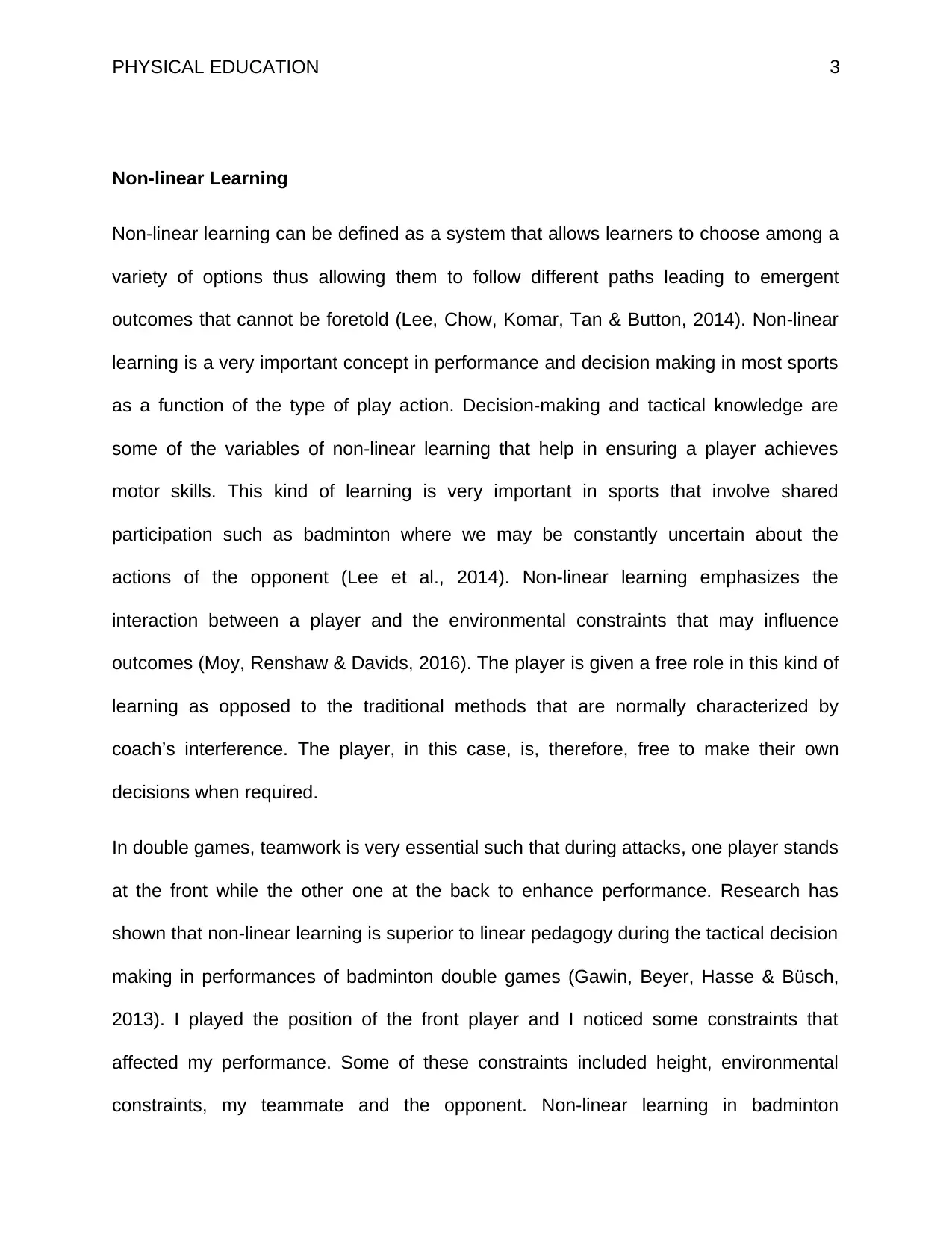
PHYSICAL EDUCATION 3
Non-linear Learning
Non-linear learning can be defined as a system that allows learners to choose among a
variety of options thus allowing them to follow different paths leading to emergent
outcomes that cannot be foretold (Lee, Chow, Komar, Tan & Button, 2014). Non-linear
learning is a very important concept in performance and decision making in most sports
as a function of the type of play action. Decision-making and tactical knowledge are
some of the variables of non-linear learning that help in ensuring a player achieves
motor skills. This kind of learning is very important in sports that involve shared
participation such as badminton where we may be constantly uncertain about the
actions of the opponent (Lee et al., 2014). Non-linear learning emphasizes the
interaction between a player and the environmental constraints that may influence
outcomes (Moy, Renshaw & Davids, 2016). The player is given a free role in this kind of
learning as opposed to the traditional methods that are normally characterized by
coach’s interference. The player, in this case, is, therefore, free to make their own
decisions when required.
In double games, teamwork is very essential such that during attacks, one player stands
at the front while the other one at the back to enhance performance. Research has
shown that non-linear learning is superior to linear pedagogy during the tactical decision
making in performances of badminton double games (Gawin, Beyer, Hasse & Büsch,
2013). I played the position of the front player and I noticed some constraints that
affected my performance. Some of these constraints included height, environmental
constraints, my teammate and the opponent. Non-linear learning in badminton
Non-linear Learning
Non-linear learning can be defined as a system that allows learners to choose among a
variety of options thus allowing them to follow different paths leading to emergent
outcomes that cannot be foretold (Lee, Chow, Komar, Tan & Button, 2014). Non-linear
learning is a very important concept in performance and decision making in most sports
as a function of the type of play action. Decision-making and tactical knowledge are
some of the variables of non-linear learning that help in ensuring a player achieves
motor skills. This kind of learning is very important in sports that involve shared
participation such as badminton where we may be constantly uncertain about the
actions of the opponent (Lee et al., 2014). Non-linear learning emphasizes the
interaction between a player and the environmental constraints that may influence
outcomes (Moy, Renshaw & Davids, 2016). The player is given a free role in this kind of
learning as opposed to the traditional methods that are normally characterized by
coach’s interference. The player, in this case, is, therefore, free to make their own
decisions when required.
In double games, teamwork is very essential such that during attacks, one player stands
at the front while the other one at the back to enhance performance. Research has
shown that non-linear learning is superior to linear pedagogy during the tactical decision
making in performances of badminton double games (Gawin, Beyer, Hasse & Büsch,
2013). I played the position of the front player and I noticed some constraints that
affected my performance. Some of these constraints included height, environmental
constraints, my teammate and the opponent. Non-linear learning in badminton
⊘ This is a preview!⊘
Do you want full access?
Subscribe today to unlock all pages.

Trusted by 1+ million students worldwide
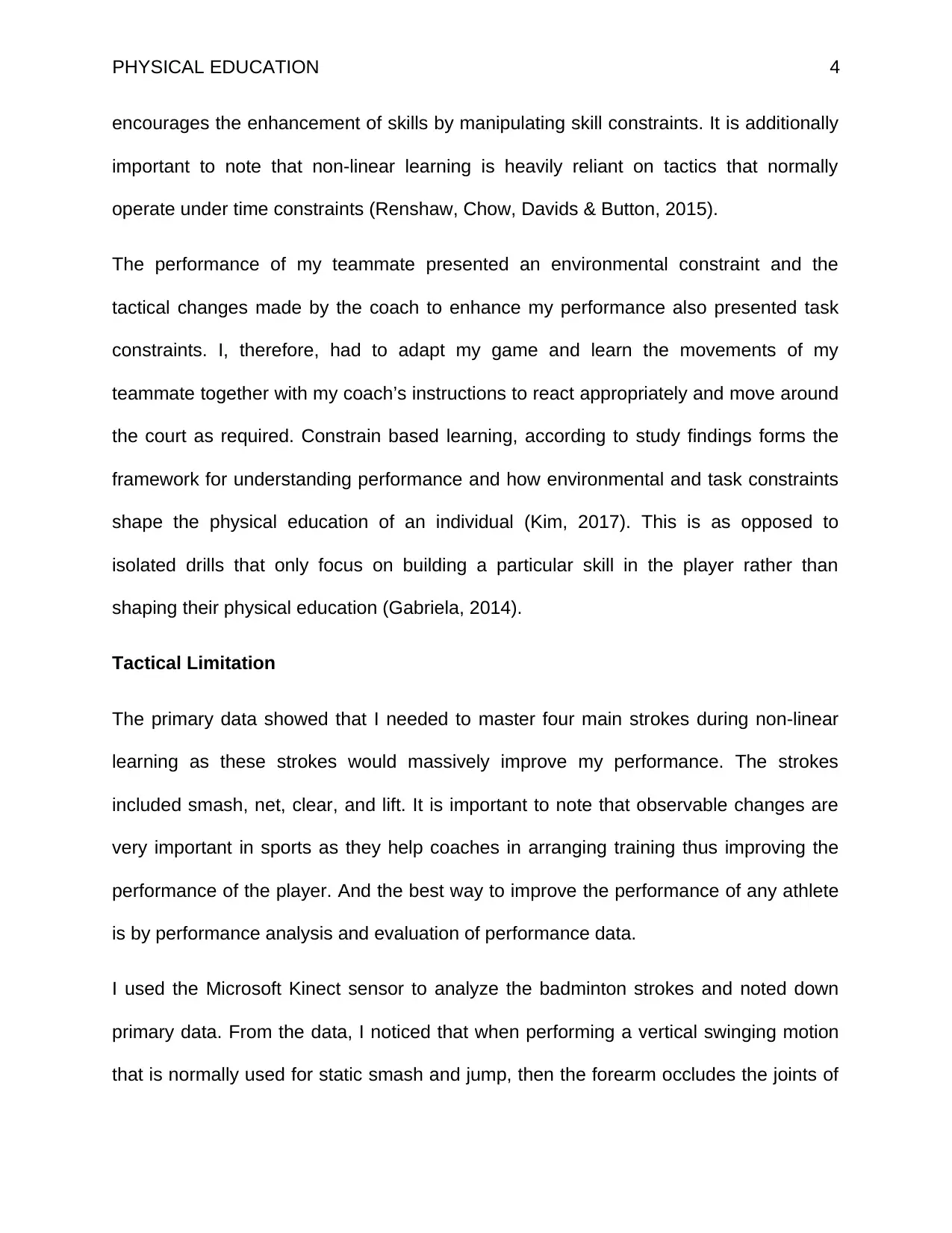
PHYSICAL EDUCATION 4
encourages the enhancement of skills by manipulating skill constraints. It is additionally
important to note that non-linear learning is heavily reliant on tactics that normally
operate under time constraints (Renshaw, Chow, Davids & Button, 2015).
The performance of my teammate presented an environmental constraint and the
tactical changes made by the coach to enhance my performance also presented task
constraints. I, therefore, had to adapt my game and learn the movements of my
teammate together with my coach’s instructions to react appropriately and move around
the court as required. Constrain based learning, according to study findings forms the
framework for understanding performance and how environmental and task constraints
shape the physical education of an individual (Kim, 2017). This is as opposed to
isolated drills that only focus on building a particular skill in the player rather than
shaping their physical education (Gabriela, 2014).
Tactical Limitation
The primary data showed that I needed to master four main strokes during non-linear
learning as these strokes would massively improve my performance. The strokes
included smash, net, clear, and lift. It is important to note that observable changes are
very important in sports as they help coaches in arranging training thus improving the
performance of the player. And the best way to improve the performance of any athlete
is by performance analysis and evaluation of performance data.
I used the Microsoft Kinect sensor to analyze the badminton strokes and noted down
primary data. From the data, I noticed that when performing a vertical swinging motion
that is normally used for static smash and jump, then the forearm occludes the joints of
encourages the enhancement of skills by manipulating skill constraints. It is additionally
important to note that non-linear learning is heavily reliant on tactics that normally
operate under time constraints (Renshaw, Chow, Davids & Button, 2015).
The performance of my teammate presented an environmental constraint and the
tactical changes made by the coach to enhance my performance also presented task
constraints. I, therefore, had to adapt my game and learn the movements of my
teammate together with my coach’s instructions to react appropriately and move around
the court as required. Constrain based learning, according to study findings forms the
framework for understanding performance and how environmental and task constraints
shape the physical education of an individual (Kim, 2017). This is as opposed to
isolated drills that only focus on building a particular skill in the player rather than
shaping their physical education (Gabriela, 2014).
Tactical Limitation
The primary data showed that I needed to master four main strokes during non-linear
learning as these strokes would massively improve my performance. The strokes
included smash, net, clear, and lift. It is important to note that observable changes are
very important in sports as they help coaches in arranging training thus improving the
performance of the player. And the best way to improve the performance of any athlete
is by performance analysis and evaluation of performance data.
I used the Microsoft Kinect sensor to analyze the badminton strokes and noted down
primary data. From the data, I noticed that when performing a vertical swinging motion
that is normally used for static smash and jump, then the forearm occludes the joints of
Paraphrase This Document
Need a fresh take? Get an instant paraphrase of this document with our AI Paraphraser
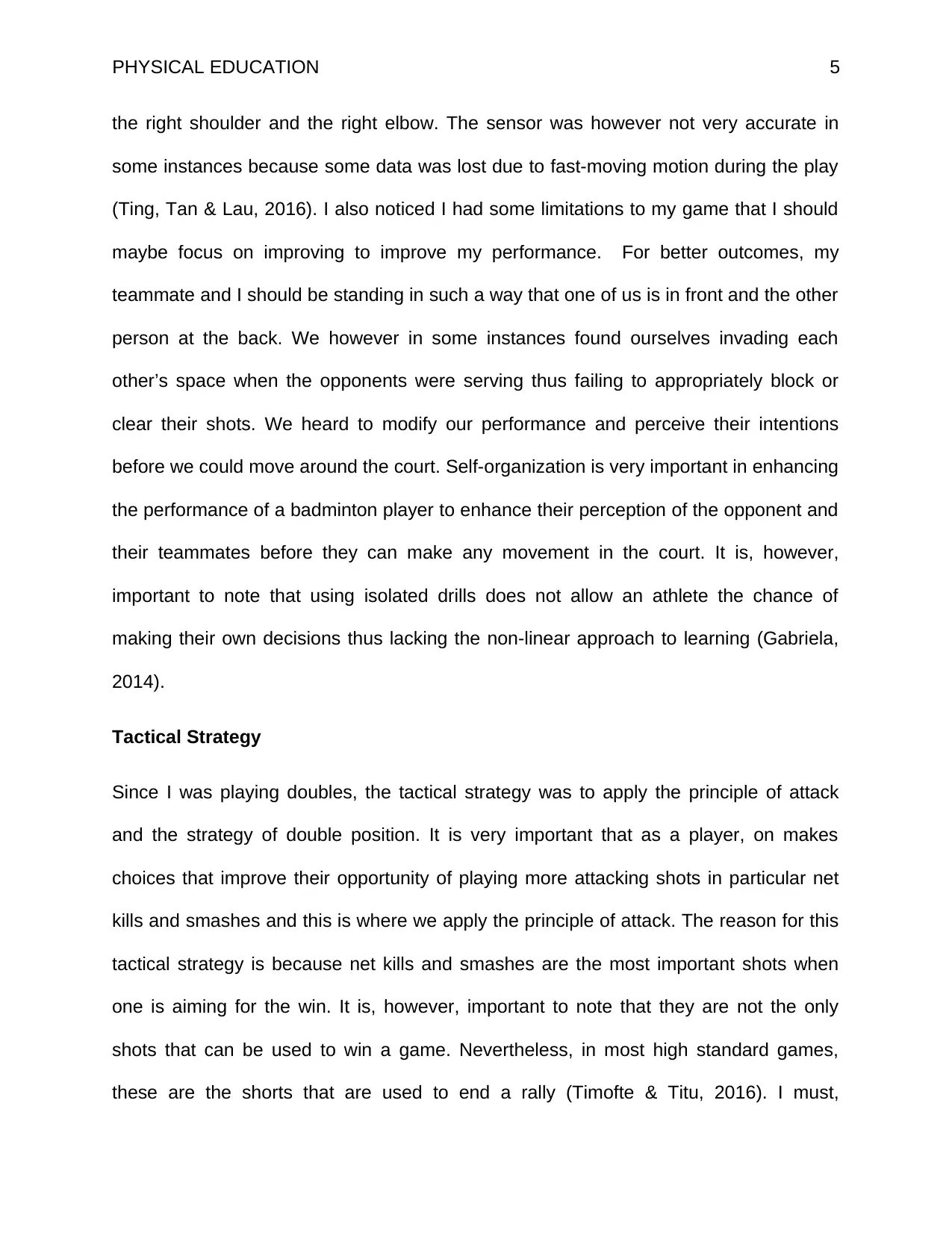
PHYSICAL EDUCATION 5
the right shoulder and the right elbow. The sensor was however not very accurate in
some instances because some data was lost due to fast-moving motion during the play
(Ting, Tan & Lau, 2016). I also noticed I had some limitations to my game that I should
maybe focus on improving to improve my performance. For better outcomes, my
teammate and I should be standing in such a way that one of us is in front and the other
person at the back. We however in some instances found ourselves invading each
other’s space when the opponents were serving thus failing to appropriately block or
clear their shots. We heard to modify our performance and perceive their intentions
before we could move around the court. Self-organization is very important in enhancing
the performance of a badminton player to enhance their perception of the opponent and
their teammates before they can make any movement in the court. It is, however,
important to note that using isolated drills does not allow an athlete the chance of
making their own decisions thus lacking the non-linear approach to learning (Gabriela,
2014).
Tactical Strategy
Since I was playing doubles, the tactical strategy was to apply the principle of attack
and the strategy of double position. It is very important that as a player, on makes
choices that improve their opportunity of playing more attacking shots in particular net
kills and smashes and this is where we apply the principle of attack. The reason for this
tactical strategy is because net kills and smashes are the most important shots when
one is aiming for the win. It is, however, important to note that they are not the only
shots that can be used to win a game. Nevertheless, in most high standard games,
these are the shorts that are used to end a rally (Timofte & Titu, 2016). I must,
the right shoulder and the right elbow. The sensor was however not very accurate in
some instances because some data was lost due to fast-moving motion during the play
(Ting, Tan & Lau, 2016). I also noticed I had some limitations to my game that I should
maybe focus on improving to improve my performance. For better outcomes, my
teammate and I should be standing in such a way that one of us is in front and the other
person at the back. We however in some instances found ourselves invading each
other’s space when the opponents were serving thus failing to appropriately block or
clear their shots. We heard to modify our performance and perceive their intentions
before we could move around the court. Self-organization is very important in enhancing
the performance of a badminton player to enhance their perception of the opponent and
their teammates before they can make any movement in the court. It is, however,
important to note that using isolated drills does not allow an athlete the chance of
making their own decisions thus lacking the non-linear approach to learning (Gabriela,
2014).
Tactical Strategy
Since I was playing doubles, the tactical strategy was to apply the principle of attack
and the strategy of double position. It is very important that as a player, on makes
choices that improve their opportunity of playing more attacking shots in particular net
kills and smashes and this is where we apply the principle of attack. The reason for this
tactical strategy is because net kills and smashes are the most important shots when
one is aiming for the win. It is, however, important to note that they are not the only
shots that can be used to win a game. Nevertheless, in most high standard games,
these are the shorts that are used to end a rally (Timofte & Titu, 2016). I must,
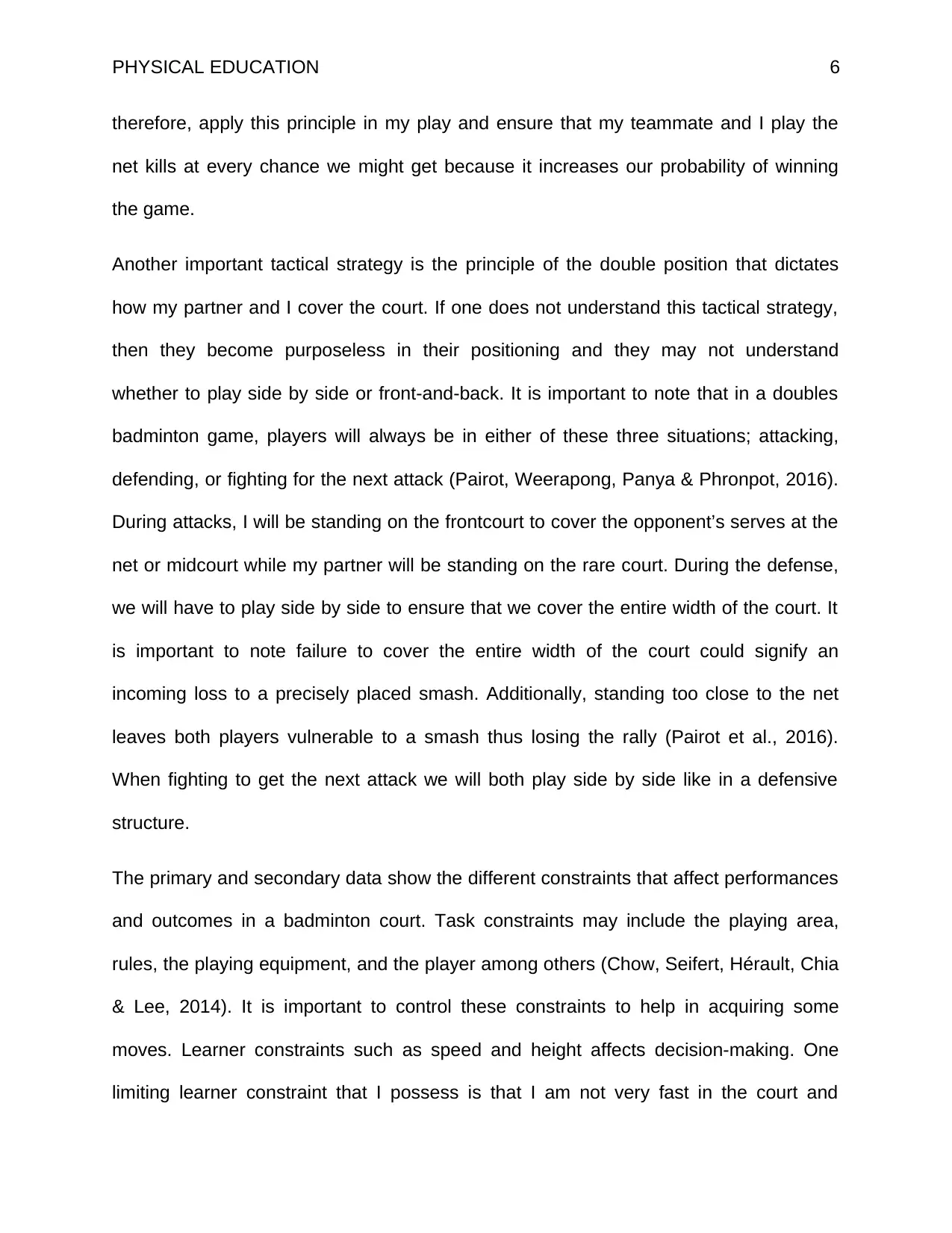
PHYSICAL EDUCATION 6
therefore, apply this principle in my play and ensure that my teammate and I play the
net kills at every chance we might get because it increases our probability of winning
the game.
Another important tactical strategy is the principle of the double position that dictates
how my partner and I cover the court. If one does not understand this tactical strategy,
then they become purposeless in their positioning and they may not understand
whether to play side by side or front-and-back. It is important to note that in a doubles
badminton game, players will always be in either of these three situations; attacking,
defending, or fighting for the next attack (Pairot, Weerapong, Panya & Phronpot, 2016).
During attacks, I will be standing on the frontcourt to cover the opponent’s serves at the
net or midcourt while my partner will be standing on the rare court. During the defense,
we will have to play side by side to ensure that we cover the entire width of the court. It
is important to note failure to cover the entire width of the court could signify an
incoming loss to a precisely placed smash. Additionally, standing too close to the net
leaves both players vulnerable to a smash thus losing the rally (Pairot et al., 2016).
When fighting to get the next attack we will both play side by side like in a defensive
structure.
The primary and secondary data show the different constraints that affect performances
and outcomes in a badminton court. Task constraints may include the playing area,
rules, the playing equipment, and the player among others (Chow, Seifert, Hérault, Chia
& Lee, 2014). It is important to control these constraints to help in acquiring some
moves. Learner constraints such as speed and height affects decision-making. One
limiting learner constraint that I possess is that I am not very fast in the court and
therefore, apply this principle in my play and ensure that my teammate and I play the
net kills at every chance we might get because it increases our probability of winning
the game.
Another important tactical strategy is the principle of the double position that dictates
how my partner and I cover the court. If one does not understand this tactical strategy,
then they become purposeless in their positioning and they may not understand
whether to play side by side or front-and-back. It is important to note that in a doubles
badminton game, players will always be in either of these three situations; attacking,
defending, or fighting for the next attack (Pairot, Weerapong, Panya & Phronpot, 2016).
During attacks, I will be standing on the frontcourt to cover the opponent’s serves at the
net or midcourt while my partner will be standing on the rare court. During the defense,
we will have to play side by side to ensure that we cover the entire width of the court. It
is important to note failure to cover the entire width of the court could signify an
incoming loss to a precisely placed smash. Additionally, standing too close to the net
leaves both players vulnerable to a smash thus losing the rally (Pairot et al., 2016).
When fighting to get the next attack we will both play side by side like in a defensive
structure.
The primary and secondary data show the different constraints that affect performances
and outcomes in a badminton court. Task constraints may include the playing area,
rules, the playing equipment, and the player among others (Chow, Seifert, Hérault, Chia
& Lee, 2014). It is important to control these constraints to help in acquiring some
moves. Learner constraints such as speed and height affects decision-making. One
limiting learner constraint that I possess is that I am not very fast in the court and
⊘ This is a preview!⊘
Do you want full access?
Subscribe today to unlock all pages.

Trusted by 1+ million students worldwide
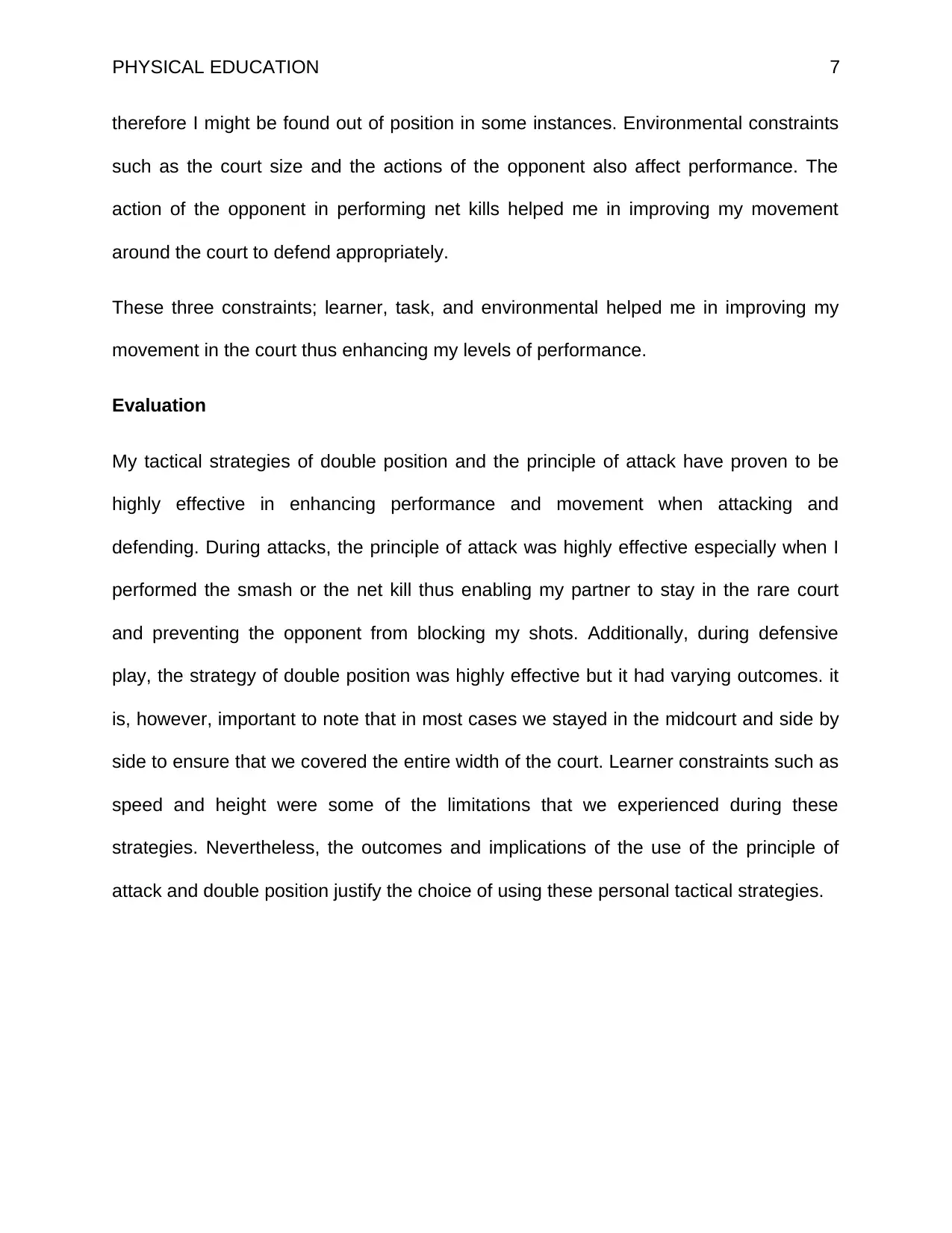
PHYSICAL EDUCATION 7
therefore I might be found out of position in some instances. Environmental constraints
such as the court size and the actions of the opponent also affect performance. The
action of the opponent in performing net kills helped me in improving my movement
around the court to defend appropriately.
These three constraints; learner, task, and environmental helped me in improving my
movement in the court thus enhancing my levels of performance.
Evaluation
My tactical strategies of double position and the principle of attack have proven to be
highly effective in enhancing performance and movement when attacking and
defending. During attacks, the principle of attack was highly effective especially when I
performed the smash or the net kill thus enabling my partner to stay in the rare court
and preventing the opponent from blocking my shots. Additionally, during defensive
play, the strategy of double position was highly effective but it had varying outcomes. it
is, however, important to note that in most cases we stayed in the midcourt and side by
side to ensure that we covered the entire width of the court. Learner constraints such as
speed and height were some of the limitations that we experienced during these
strategies. Nevertheless, the outcomes and implications of the use of the principle of
attack and double position justify the choice of using these personal tactical strategies.
therefore I might be found out of position in some instances. Environmental constraints
such as the court size and the actions of the opponent also affect performance. The
action of the opponent in performing net kills helped me in improving my movement
around the court to defend appropriately.
These three constraints; learner, task, and environmental helped me in improving my
movement in the court thus enhancing my levels of performance.
Evaluation
My tactical strategies of double position and the principle of attack have proven to be
highly effective in enhancing performance and movement when attacking and
defending. During attacks, the principle of attack was highly effective especially when I
performed the smash or the net kill thus enabling my partner to stay in the rare court
and preventing the opponent from blocking my shots. Additionally, during defensive
play, the strategy of double position was highly effective but it had varying outcomes. it
is, however, important to note that in most cases we stayed in the midcourt and side by
side to ensure that we covered the entire width of the court. Learner constraints such as
speed and height were some of the limitations that we experienced during these
strategies. Nevertheless, the outcomes and implications of the use of the principle of
attack and double position justify the choice of using these personal tactical strategies.
Paraphrase This Document
Need a fresh take? Get an instant paraphrase of this document with our AI Paraphraser
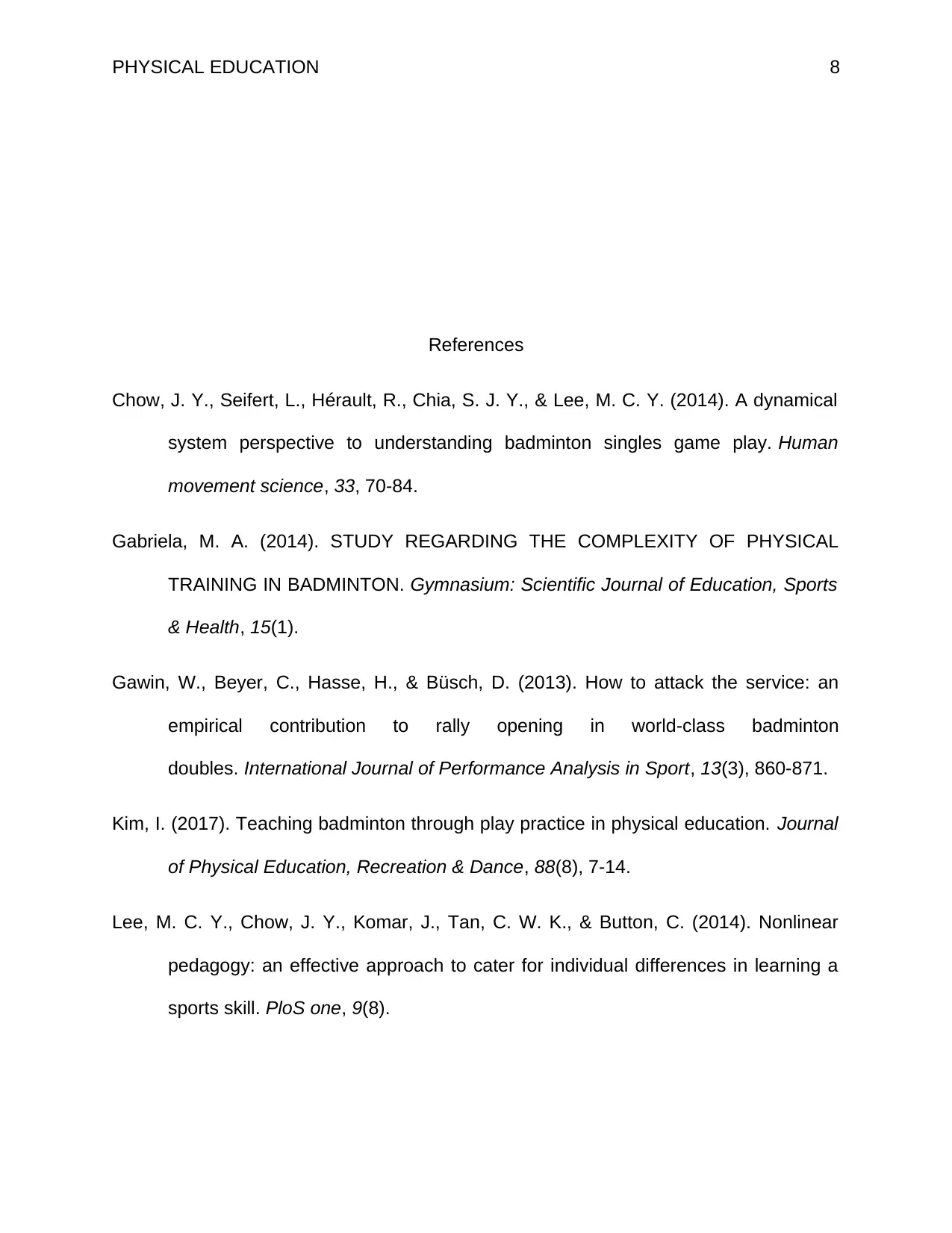
PHYSICAL EDUCATION 8
References
Chow, J. Y., Seifert, L., Hérault, R., Chia, S. J. Y., & Lee, M. C. Y. (2014). A dynamical
system perspective to understanding badminton singles game play. Human
movement science, 33, 70-84.
Gabriela, M. A. (2014). STUDY REGARDING THE COMPLEXITY OF PHYSICAL
TRAINING IN BADMINTON. Gymnasium: Scientific Journal of Education, Sports
& Health, 15(1).
Gawin, W., Beyer, C., Hasse, H., & Büsch, D. (2013). How to attack the service: an
empirical contribution to rally opening in world-class badminton
doubles. International Journal of Performance Analysis in Sport, 13(3), 860-871.
Kim, I. (2017). Teaching badminton through play practice in physical education. Journal
of Physical Education, Recreation & Dance, 88(8), 7-14.
Lee, M. C. Y., Chow, J. Y., Komar, J., Tan, C. W. K., & Button, C. (2014). Nonlinear
pedagogy: an effective approach to cater for individual differences in learning a
sports skill. PloS one, 9(8).
References
Chow, J. Y., Seifert, L., Hérault, R., Chia, S. J. Y., & Lee, M. C. Y. (2014). A dynamical
system perspective to understanding badminton singles game play. Human
movement science, 33, 70-84.
Gabriela, M. A. (2014). STUDY REGARDING THE COMPLEXITY OF PHYSICAL
TRAINING IN BADMINTON. Gymnasium: Scientific Journal of Education, Sports
& Health, 15(1).
Gawin, W., Beyer, C., Hasse, H., & Büsch, D. (2013). How to attack the service: an
empirical contribution to rally opening in world-class badminton
doubles. International Journal of Performance Analysis in Sport, 13(3), 860-871.
Kim, I. (2017). Teaching badminton through play practice in physical education. Journal
of Physical Education, Recreation & Dance, 88(8), 7-14.
Lee, M. C. Y., Chow, J. Y., Komar, J., Tan, C. W. K., & Button, C. (2014). Nonlinear
pedagogy: an effective approach to cater for individual differences in learning a
sports skill. PloS one, 9(8).
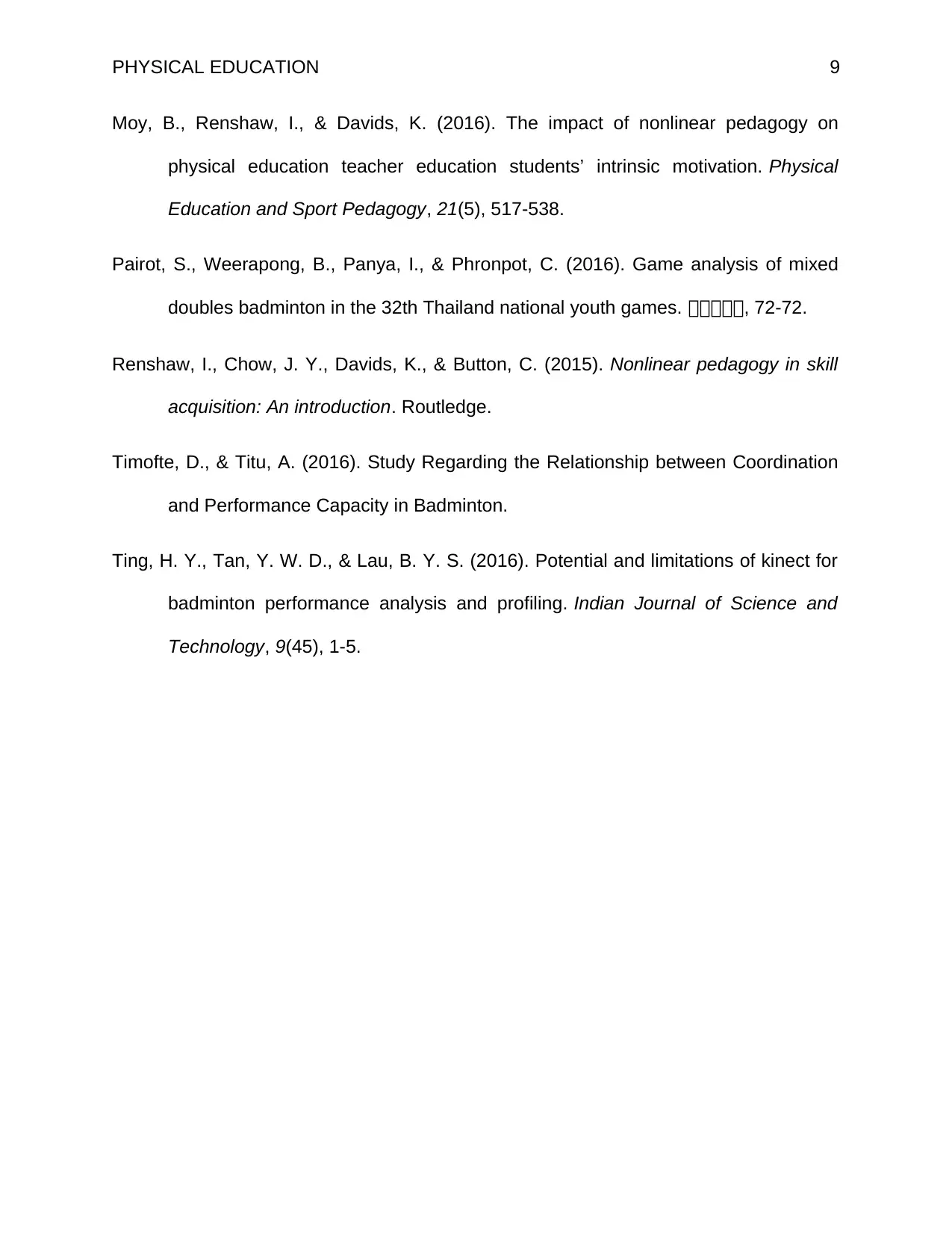
PHYSICAL EDUCATION 9
Moy, B., Renshaw, I., & Davids, K. (2016). The impact of nonlinear pedagogy on
physical education teacher education students’ intrinsic motivation. Physical
Education and Sport Pedagogy, 21(5), 517-538.
Pairot, S., Weerapong, B., Panya, I., & Phronpot, C. (2016). Game analysis of mixed
doubles badminton in the 32th Thailand national youth games. 운운운운운, 72-72.
Renshaw, I., Chow, J. Y., Davids, K., & Button, C. (2015). Nonlinear pedagogy in skill
acquisition: An introduction. Routledge.
Timofte, D., & Titu, A. (2016). Study Regarding the Relationship between Coordination
and Performance Capacity in Badminton.
Ting, H. Y., Tan, Y. W. D., & Lau, B. Y. S. (2016). Potential and limitations of kinect for
badminton performance analysis and profiling. Indian Journal of Science and
Technology, 9(45), 1-5.
Moy, B., Renshaw, I., & Davids, K. (2016). The impact of nonlinear pedagogy on
physical education teacher education students’ intrinsic motivation. Physical
Education and Sport Pedagogy, 21(5), 517-538.
Pairot, S., Weerapong, B., Panya, I., & Phronpot, C. (2016). Game analysis of mixed
doubles badminton in the 32th Thailand national youth games. 운운운운운, 72-72.
Renshaw, I., Chow, J. Y., Davids, K., & Button, C. (2015). Nonlinear pedagogy in skill
acquisition: An introduction. Routledge.
Timofte, D., & Titu, A. (2016). Study Regarding the Relationship between Coordination
and Performance Capacity in Badminton.
Ting, H. Y., Tan, Y. W. D., & Lau, B. Y. S. (2016). Potential and limitations of kinect for
badminton performance analysis and profiling. Indian Journal of Science and
Technology, 9(45), 1-5.
⊘ This is a preview!⊘
Do you want full access?
Subscribe today to unlock all pages.

Trusted by 1+ million students worldwide
1 out of 9
Your All-in-One AI-Powered Toolkit for Academic Success.
+13062052269
info@desklib.com
Available 24*7 on WhatsApp / Email
![[object Object]](/_next/static/media/star-bottom.7253800d.svg)
Unlock your academic potential
Copyright © 2020–2025 A2Z Services. All Rights Reserved. Developed and managed by ZUCOL.
